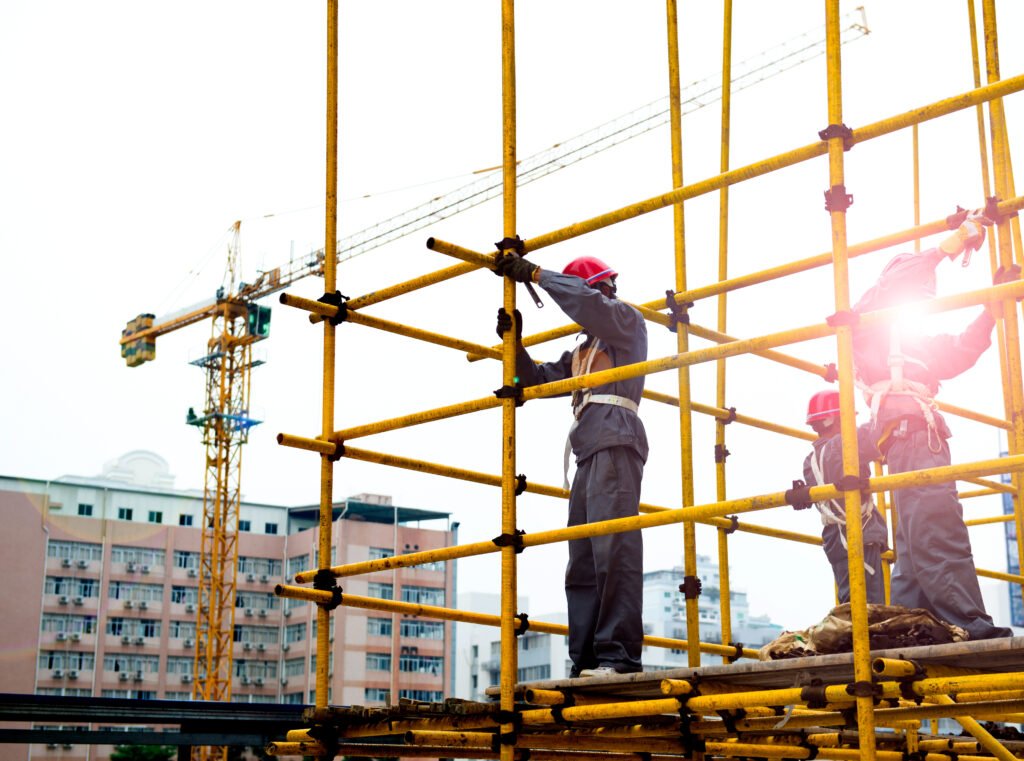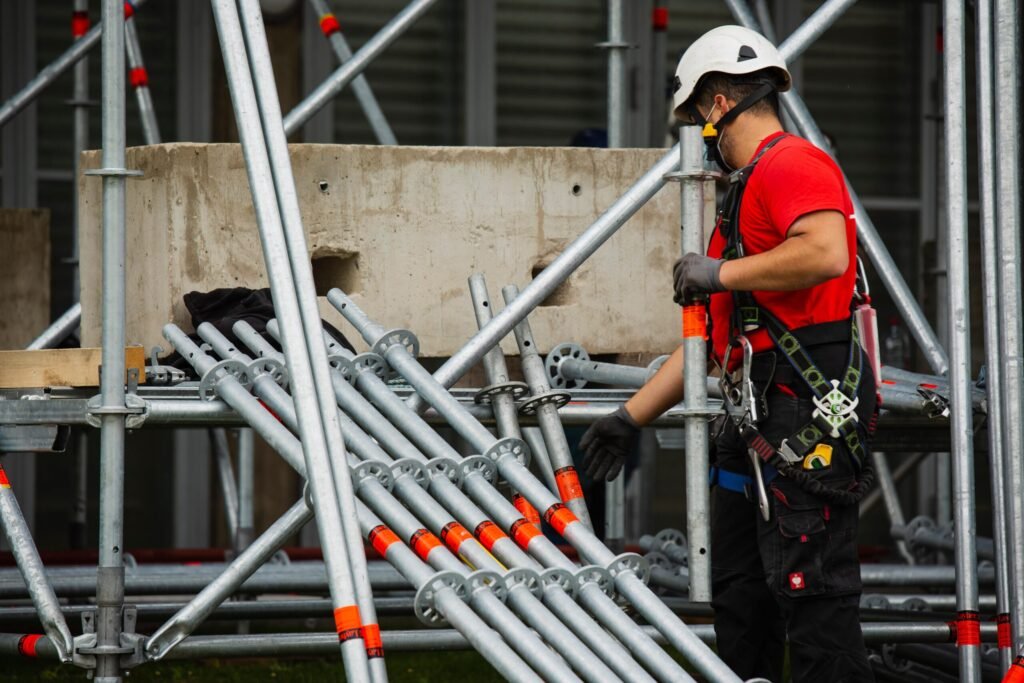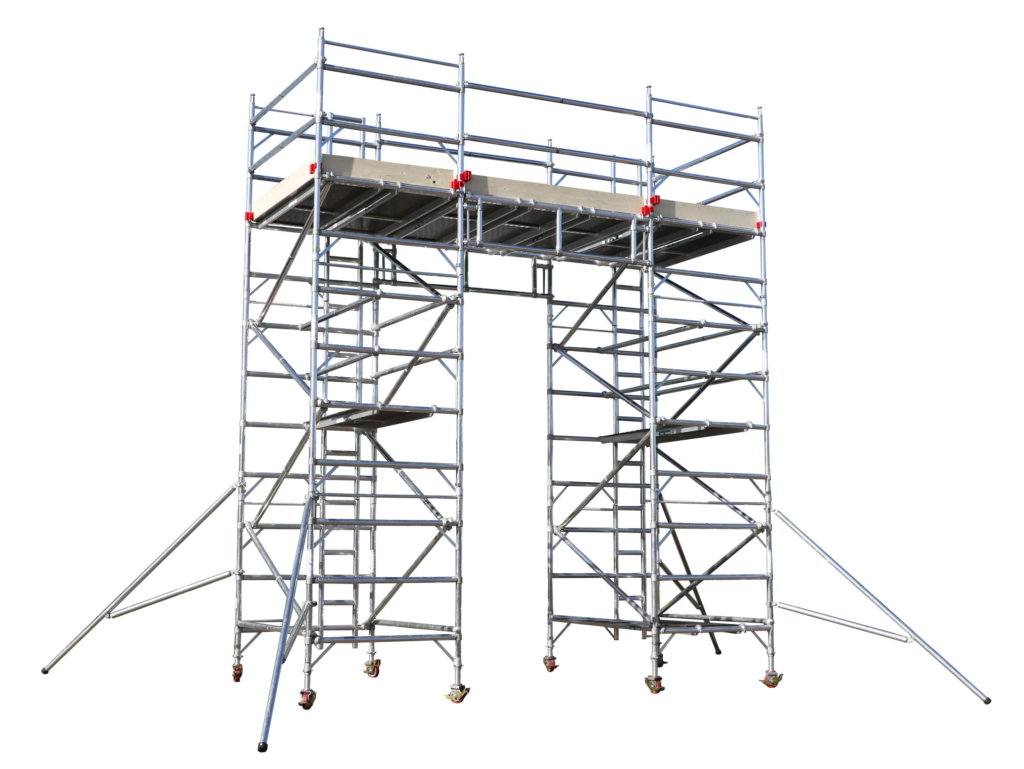Scaffolding in Modern Industry: Benefits, Risks, and Drone-Powered Alternatives
Scaffolding has been an integral part of construction and industrial work for thousands of years. From ancient civilizations building monumental structures to modern skyscrapers, this temporary framework has provided workers with access, stability, and safety when working at height.
But as technology evolves, so do the methods for completing work safely and efficiently. In this article, we’ll explore scaffolding’s history, benefits, risks, applications, and how emerging drone technology is transforming the way industries approach work at height.
What Is Scaffolding?
Scaffolding, also called a scaffold or staging, is a temporary structure used to support workers and materials in construction, maintenance, inspection, and cleaning projects. It is typically built using metal poles and wooden planks, though modern variations also incorporate aluminum and composite materials.
Evidence suggests that scaffolding dates back over 17,000 years, with early examples found in the Paleolithic cave paintings at Lascaux. Ancient China and Egypt also used primitive scaffolds made from wood and rope to build their monumental architecture.
Today, scaffolding has evolved into a highly engineered system, available in various types and designs to suit different tasks and environments.
Benefits of Scaffolding
Despite technological advancements, scaffolding remains widely used because it works — and works well. Here’s why:
- Access – Provides stable access to hard-to-reach areas of a structure.
- Balance – Offers a solid platform for workers to maintain their footing while working in different positions.
- Ease of Assembly – Quick to set up and dismantle.
- Durability – With proper maintenance, scaffolding can last for years.
- Safety – Reduces the risk of falls by providing a secure working surface.
- Efficiency – Bridging points in scaffolding minimize unnecessary walking and wasted time.

Risks and Safety Concerns
While scaffolding is designed to improve safety, working at height always carries inherent risks. According to OSHA:
- Scaffold-related accidents cause 4,500 injuries and 60 deaths annually in the U.S.
- Falls from scaffolding account for 25% of all workplace fatalities.
- 72% of accidents are linked to planking failure, slipping, or falling objects.
Common hazards include:
- Defects – Faulty poles, loose screws, or damaged planks.
- Falling Objects – Tools, debris, or materials striking workers below.
- Weather – Rain, snow, or wind making surfaces slippery or unstable.
- Poor Construction – Missing guardrails, improper bracing, or weak joints.
- Inadequate Training – Unskilled workers erecting or using scaffolding incorrectly.
- Negligence – Overloading, improper use, or ignoring safety protocols.
Common Uses of Scaffolding
Scaffolding serves multiple purposes across industries, including:
- Cleaning – Exterior window washing or facade cleaning for tall buildings.
- Construction – Providing elevated platforms for building and repair work.
- Industrial Inspections – Access for visual checks, NDT testing, and equipment maintenance.
- Maintenance – Repairing defects found during inspections.
- Events & Structures – Art installations, stages, grandstands, observation towers, and ski ramps.
Alternatives to Traditional Scaffolding
While scaffolding remains essential in many projects, inspection drones are now offering a safer, faster, and more cost-effective alternative, especially in industrial inspections.
Benefits of Using Drones Instead of Scaffolding
- Enhanced Safety – No need for workers to operate at dangerous heights.
- Significant Cost Savings – Avoids the high expenses of scaffold setup and removal.
- Reduced Downtime – Minimizes operational interruptions.
- Speed – Data collection is faster than manual inspection.
- Flexibility – Modern drones can carry various sensors for specific inspection needs.
For example, the Flyability Elios 3 can navigate tight indoor spaces and collect high-quality visual data, reducing — or even eliminating — the need for internal scaffolding in many inspections.
The Four Main Scaffolding Materials: Advantages, Disadvantages, and Applications
Scaffolding plays a critical role in construction, maintenance, and industrial projects, providing workers with safe and efficient access to elevated work areas.
Choosing the right scaffolding material can significantly impact safety, cost, and productivity.
Below, we explore the four main types of scaffolding materials — wood, aluminum, steel, and fiberglass — along with their benefits, limitations, and best applications.
1. Wood
Wood was once the most common scaffolding material before the rise of metals like steel and aluminum. Today, its use is mostly limited to platform boards or in cultural practices such as bamboo scaffolding in Asia.
Advantages
- Lightweight – Easy to transport and handle.
- Affordable – Low cost in regions where timber is abundant.
- Easy to work with – Can be cut and assembled on-site without specialized tools.
- Bamboo option – Highly sustainable, flexible, and culturally significant in some regions.
Disadvantages
- Lower strength – Cannot handle extremely heavy loads like steel.
- High maintenance – Vulnerable to rot, pests, and cracks.
- Environmental impact – Deforestation concerns.
- Weather sensitivity – Can swell, shrink, or warp with changing conditions.
Best Applications
- Platform boards in modern scaffolding systems.
- Bamboo scaffolding for local construction in Asia.
- Short-term, light-duty construction where heavy loads are not a concern.
2. Aluminum
Aluminum scaffolding is a lightweight and versatile option, increasingly popular in regions where labor costs are high.
Advantages
- Lightweight – Easier to transport, erect, and dismantle than steel.
- Corrosion-resistant – Naturally forms an oxide layer for weather protection.
- Labor-saving – Reduces setup time and worker fatigue.
Disadvantages
- Less stability – Not ideal for tall structures due to reduced weight stability.
- Higher material cost – Generally more expensive than steel.
Best Applications
- Suspended scaffolding that requires mobility.
- Pump jacks and projects with frequent repositioning.
- Construction in high-labor-cost regions (e.g., Northern Europe).

3. Steel
Steel is the most widely used scaffolding material today due to its strength and durability.
Advantages
- High load capacity – Can handle heavy equipment and materials.
- Strong and stable – Ideal for tall structures and high wind conditions.
- Flexible in design – Can be adapted to fit various building shapes.
Disadvantages
- Heavy – Requires more effort to transport and assemble.
- Corrosion risk – Needs galvanization, painting, or stainless steel to resist rust.
Best Applications
- Tube and clamp scaffolding for versatile builds.
- High-rise construction.
- Projects needing heavy-duty load-bearing capacity.
4. Fiberglass
Fiberglass scaffolding is a specialized material mainly used in environments where electrical hazards are present.
Advantages
- Non-conductive – Excellent insulation against electricity.
- Fire-resistant – High safety in hazardous environments.
- Corrosion-resistant – Suitable for chemical plants and marine environments.
Disadvantages
- High cost – More expensive than steel or aluminum.
- Limited use – Mostly for specialized scaffold tubes, not full systems.
Best Applications
- Electrical work near live cables.
- Maintenance in chemical plants or offshore facilities.
- Fire-risk environments.
10 Common Types of Scaffolding in Construction
1. Single Scaffolding (Brick Layer’s Scaffolding)
- Common in brick masonry work.
- Consists of standards (vertical supports), ledgers (horizontal supports), and putlogs (connections to the wall).
- Standards are placed 2–3 meters from the wall and connected at 1.2–1.5 m intervals.
2. Double Scaffolding (Stone Mason’s Scaffolding)
- Used in stone masonry where wall drilling is difficult.
- Has two rows of scaffolding for extra stability.
- Supported by rakers (diagonal supports) and cross braces.
3. Suspended Scaffolding
- Common in cleaning, painting, or repair work on tall buildings.
- Platforms are suspended by ropes or chains from the roof.
- Requires a high-risk work licence for operation.
4. Cantilever Scaffolding
- Supported only at one end using wall-inserted needles.
- Ideal when ground space is limited or unstable.
- Requires careful design due to higher load stresses.
5. Trestle Scaffolding
- Platforms supported by movable ladders or tripods.
- Great for indoor work such as painting or plastering.
- Typically no higher than 5 meters.
6. Steel Scaffolding
- Made from steel tubes connected with couplers.
- Strong, fire-resistant, and durable—perfect for high-rise construction.
- Higher initial cost but excellent safety and longevity.
7. Patented Scaffolding
- Pre-made steel scaffolding with adjustable brackets.
- Quick to set up and ideal for short-term repairs.
8. Bamboo Scaffolding
- Traditional choice in Asia for its strength and sustainability.
- Lightweight, adaptable, and eco-friendly.
9. Kwikstage Scaffolding
- Modular system with only five main components.
- Quick to assemble and adaptable for different heights.
- Features non-slip platforms and double guard rails for safety.
10. Independent Scaffolding
- Stands freely without relying on the building for support.
- Tied for stability but not structurally dependent on the wall.

Why High-Quality Scaffolding Matters
Investing in the right scaffolding system comes with major benefits:
1. Enhanced Safety
Scaffolding provides a stable and secure platform, reducing the risk of falls and injuries. Properly installed systems comply with strict safety regulations, protecting both workers and employers.
2. Better Access to Elevated Areas
Whether it’s a roof, façade, or upper-floor window, scaffolding makes hard-to-reach places accessible—safely and efficiently.
3. Increased Productivity
Workers can store tools and materials right on the platform, reducing downtime and allowing multiple trades to work simultaneously.
4. Versatility for Different Projects
From residential homes to industrial sites, scaffolding can be customised to suit any project’s requirements.
5. Time Efficiency
Aluminium scaffolding in particular allows quick setup and easy movement—speeding up project completion times.
6. Heavy Load Support
Quality scaffolding, whether aluminium or steel, can safely bear substantial weights including workers, tools, and heavy materials.
7. Regulatory Compliance
Australian safety standards often require scaffolding for certain types of elevated work, protecting you from costly legal issues.
7 Types of Projects That Require Professional Scaffolding
1. Residential Improvements
For projects like loft conversions, roof repairs, and home extensions, scaffolding ensures safe, stable, and efficient work. Hiring rather than buying is often cost-effective—especially for occasional use.
2. Painting & Exterior Work
High exterior walls or awkward access points call for scaffolding over ladders. It creates a safer, more organised workspace, reducing the risk of spills and accidents.
3. Building Repairs & Renovations
Restoration work often means accessing difficult or unsafe areas. Aluminium, steel, or cantilever scaffolds provide the stability needed for intricate repairs without compromising safety.
4. High-Rise Window Cleaning
Tall building? Scaffolding allows window cleaners to work securely at height with tools within easy reach—improving both safety and quality.
5. Commercial Projects
Large-scale builds or renovations demand robust scaffolding to maintain efficiency, comply with safety rules, and avoid costly delays.
6. Industrial Facilities
Complex industrial structures often require heavy-duty scaffolding to access machinery, inspect structures, and perform maintenance safely.
7. Building Construction
From laying bricks to installing windows, scaffolding is essential for high-rise and multi-storey construction, enabling safe access to every part of the build.

Common Causes of Scaffolding Accidents
1. Falls from Height
The most frequent and dangerous scaffolding hazard. Causes include missing guardrails, unsafe access points, platform failure, or lack of fall protection.
2. Falling Objects
Tools, materials, or debris can strike workers below—often due to unsecured items, missing toe boards, poor housekeeping, or unsafe dismantling practices.
3. Scaffold Structural Failure
Collapses can result from overloading, poor assembly, unstable ground, damaged equipment, or severe weather.
4. Platform Hazards
Wet, uneven, or cluttered surfaces can lead to slips, trips, and falls. Poor planking and gaps increase the risk.
5. Electrocution Risks
Scaffolds placed too close to power lines pose serious danger—especially with metal components that conduct electricity.
6. Lack of Training and Oversight
Untrained workers may misuse scaffolds or overlook hazards. Without proper supervision, unsafe practices can go unnoticed, and unauthorized modifications can compromise safety.
5 Proven Ways to Improve Scaffolding Safety
1. Provide Proper Training and Supervision
- Train workers on safe scaffold erection, use, and dismantling.
- Cover fall prevention, load limits, access requirements, and environmental hazards.
- Supervisors must monitor daily operations and stop unsafe practices immediately.
- Prohibit unauthorized scaffold modifications without re-inspection.
2. Use the Right Scaffolding Materials and Equipment
- Choose scaffold types (tube and fitting, system, suspended) based on project needs.
- Inspect all parts for defects, corrosion, or damage before use.
- Maintain and store components properly to extend lifespan.
3. Inspect and Maintain Scaffolds Regularly
- Inspect before each shift, after modifications, and following severe weather.
- Follow local regulations for inspection frequency.
- Keep a documented inspection record for accountability.
4. Follow Applicable Safety Codes and Regulations
- Understand your region’s scaffold safety codes (OSHA, CCOHS, HSE, EU-OSHA, etc.).
- Maintain safe distances from overhead power lines.
- De-energize lines when necessary to prevent electrocution risks.
5. Use Scaffolding Design and Visualization Software
- Replace outdated paper plans with 3D scaffold modeling tools like Avontus Designer®.
- Share designs via Avontus Viewer® for on-site access in virtual and augmented reality.
- Identify hazards before assembly, improve communication, and reduce rework.

Final Thoughts: Make Scaffolding Safety a Priority
Scaffolding safety isn’t just about compliance—it’s about protecting lives and creating a safety-first jobsite culture. By investing in training, choosing the right materials, conducting regular inspections, following regulations, and using modern design tools, you can significantly reduce risks.
When safety is prioritized, everyone benefits—your workers, your business, and your project’s success.
Choosing the Right Scaffolding for Your Project
Selecting the right scaffolding depends on:
- Project type and height requirements
- Load capacity needed
- Space availability on site
- Safety compliance and regulations
If you’re unsure, working with a professional scaffolding hire service ensures the right system is chosen, erected, and maintained for maximum safety.
The best scaffolding material depends on project requirements, budget, and safety needs:
- Wood: Affordable and traditional, but for light-duty and short-term use.
- Aluminum: Lightweight and corrosion-resistant, ideal for mobile systems.
- Steel: Strong, stable, and reliable for heavy-duty projects.
- Fiberglass: Specialized for electrical safety and corrosion resistance.
Choosing the right material is crucial to ensuring worker safety, structural stability, and cost efficiency in your construction project.
About Lux Metal Services
At Lux Metal, we specialize in providing high-quality custom metal fabrication tailored to meet the needs of construction, industrial, and commercial projects. Our expertise covers:
- Aluminium Mobile Scaffold Towers – Lightweight, durable, and compliant with industry safety standards.
- Custom Metal Fabrication – From stainless steel structures to precision components, crafted with state-of-the-art machinery.
- Bespoke Solutions – Designed to fit specific project requirements for maximum efficiency and safety.
Whether you need safe access solutions or custom-engineered metalwork, Lux Metal ensures unmatched quality and reliability from concept to completion.
🔗 Visit us at: www.luxmetalgroup.com

